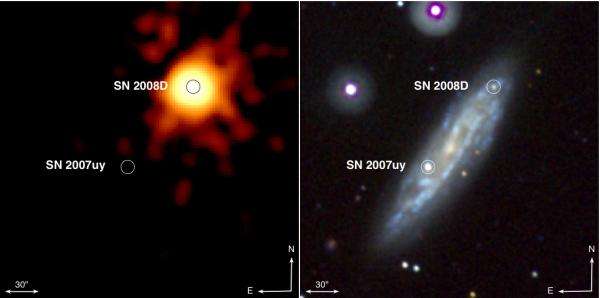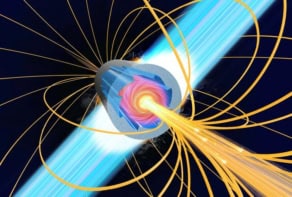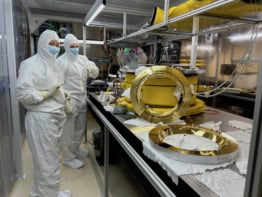
A chance observation using NASA’s Swift satellite has provided the most detailed account yet of a star exploding into a supernova.
Alicia Soderberg of Princeton University, US, happened to be monitoring the aftermath of a month-old supernova with Swift’s X-ray telescope on 9 January this year when she spotted a burst of radiation in the same galaxy. “When I saw this exciting new source, I originally considered that it may be some other flavour of energetic cosmic explosion, unrelated to massive star death,” she told physicsworld.com.
The source, now identified as SN 2008D, marks the first time a star has been caught turning into a “type-Ib” supernova (Nature 453 469).
Several hundred supernovae are recorded every year in the nearer regions of the universe, although the light that typically signals the event to us is generated several days after initial explosion. The likelihood of two supernovae occurring in the same galaxy in a single month is one in 10,000, and there is an even smaller chance of someone watching it during the initial five-minute X-ray burst. “I certainly got lucky, but they say luck favours the prepared,” Soderberg says.
The trick is knowing where to look and when Alicia Soderberg, Princeton University
Shock wave
Only stars significantly more massive than our Sun turn into supernovae, and of these there are several classes. Type-Ib supernovae are thought to occur when the core of a “Wolf-Rayet” star, which is some 20 times the mass of the Sun, runs out of helium to fuel nuclear fusion, collapses and generates an intense shock wave.
As this shock wave expands outwards, it breaks out through the surface layers into the star’s “wind” of charged particles, whereupon it produces a burst of X-rays. When Soderberg glimpsed this event for SN 2008D on her computer screen, she and her colleague Edo Berger alerted eight other ground- and space-based telescopes to study it. “The trick is knowing where to look and when,” she says. “The X-rays that accompany the explosion are extremely bright but very short lived.”
Although the observations taken of the early shockwave-breakout of SN 2008D reveal little about the explosion mechanism of type-Ib supernovae, they do provide a better understanding of the star’s outer layers, its mass-loss rate and — roughly — its explosion energy, which was about 1051 erg (equivalent to 1027 one-megaton hydrogen bombs).
“We never observe the stars themselves at such a late point [before the explosion]; the time is too brief,” says Stan Woosley of the University of California at Santa Cruz. “Yet the star is doing very different things in its last few years — oxygen burning the last few months, silicon burning the last few days, and its mass structure could change a lot. Now we know it doesn’t.”
An all-sky X-ray telescope could pinpoint hundreds of supernovae as they explode Jens Hjorth, University of Copenhagen
Other events
Perhaps the most fruitful consequence of Soderberg and Berger’s observation is that it gives a precise time when the X-ray emission occurs. This will help physicists look for events related to astronomical explosions, such as gravitational waves and neutrino bursts. It will also allow other core-collapse supernovae to be spotted by looking for the particular X-ray signature.
“An all-sky X-ray telescope could pinpoint hundreds of supernovae as they explode,” says Jens Hjorth of the University of Copenhagen. “No doubt, such a wealth of information would be invaluable in elucidating the nature of supernovae, their progenitors and the detailed physics involved.”
The publication of the supernova X-ray observation by Soderberg and Berger comes just days after Swift — which is maybe better known for its data on gamma rays — was ranked as the highest priority orbiting mission in a review by NASA.



